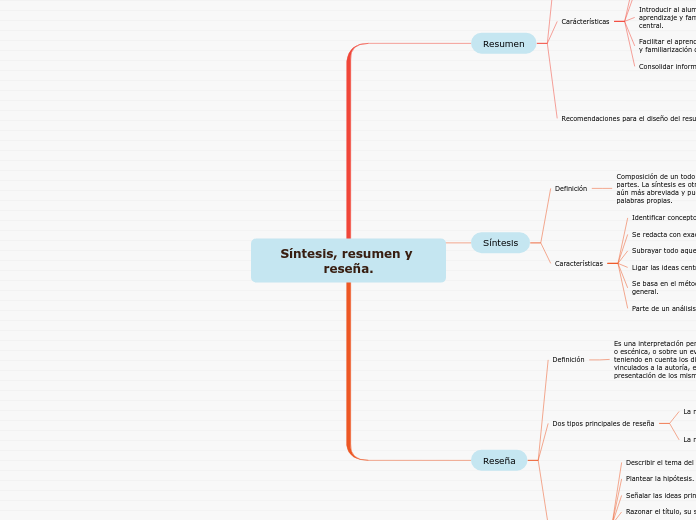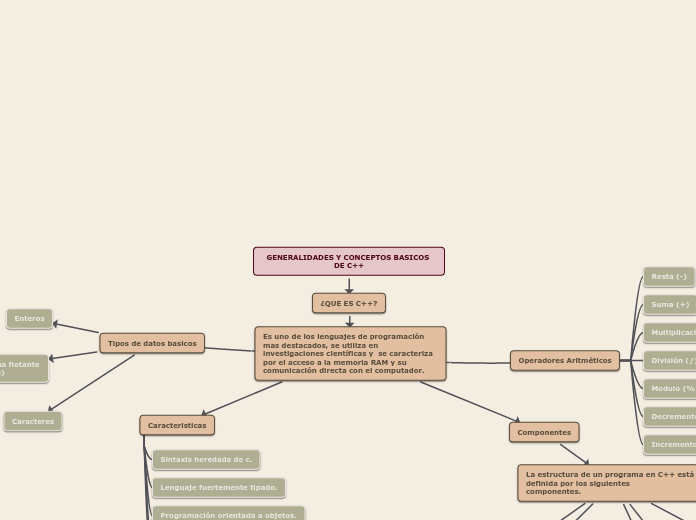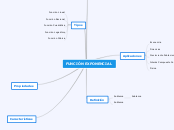Síntesis, resumen y reseña.
To name your story, you have to think about the overall message and what you want your audience to understand from the story. Also, make it relevant and easy to remember.
Reseña
The ending of a story is essential. We all know that if the ending is weak, what happened before loses its importance. So make it unpredictable, but fair. A resolved ending answers all the questions and ties up any loose threads from the plot.
Característica
Señalar los datos bibliográficos del autor.
Leer el documento en su totalidad.
Evitar reseñar el texto narrando todo el argumento.
Exponer el contenido del texto y después presentar un comentario.
Razonar el título, su significado y su implementación.
Señalar las ideas principales que el autor aborda.
Plantear la hipótesis.
Describir el tema del texto o documento que estudia.
Dos tipos principales de reseña
This is the closure section of the story.
See examples of possible outcomes below:
- all problems have been solved
- it's clear how each one of your characters ends up
- your main character is transformed by the challenge
La reseña bibliográfica.
Tiende más a informar sobre una novedad editorial, su contenido y su importancia.
La reseña crítica.
Try answering these questions to come up with a closure:
- Have all the problems been solved?
- Is there a clear picture of what happens with each character in the story?
- Has the challenge transformed your main character?
- How do the characters feel in the end?
Tiene como objetivo juzgar a través de un análisis minucioso y exhaustivo. Emite un juicio de valor y calidad.
This is the moment when the main character surpasses the last obstacle and finally faces their greatest challenge.
The climax usually follows one of these patterns:
- realization
- resolution
- choice
Type in your answer.
Es una interpretación personal sobre una obra escrita, gráfica o escénica, o sobre un evento determinado. Se desarrolla teniendo en cuenta los diferentes aspectos contextuales vinculados a la autoría, ejecución, producción, publicación, presentación de los mismos.
La reseña pueden dividirse en reseñas de libros, cinematográficas, deportivas, de exposiciones, etc.
Otro identificador de la reseña es la brevedad.
Intenta compulsar al lector a una evaluación personal de una obra.
Síntesis
The middle of the story is where you add layers of complications that will lead to the end. Reveal more about the character's journey. Did their personality go through changes? How did they overcome the challenges? And as you build up the story’s central conflict, make it more personal to that character. Also, from the middle act, you have to lead into the final act.
Características
Your character(s) need(s) motivation in order to solve the challenge(s).
Parte de un análisis.
Secondary characters might also have motives that lead them to cross paths with the main character or which might trigger them to help the main character.
Se basa en el método inductivo, de lo particular a lo general.
Why does your character need to confront this challenge? What does he/she expect to accomplish by solving it?
See a few examples:
- will marry in 3 days
- can fix the mistakes of the past
Ligar las ideas centrales parafraseando.
Subrayar todo aquello que sea relevante.
Se redacta con exactitud, fidelidad y claridad.
Identificar conceptos centrales.
Secondary characters also might have motivs beacuse of which they may cross path with main character or which might trigger them to help the main character.
Motivation
Each story has a main character and that character usually needs to solve a problem or challenge. The character's challenge is the one that creates tension throughout the story.
Composición de un todo por la reunión de sus partes. La síntesis es otra forma de resumen pero aún más abreviada y puede parafrasearse con palabras propias.
In most stories, there are 3 challenges. The number 3 is a mystical number symbolizing completeness. Try to come up with interesting challenges with which your character needs to struggle.
See a few examples below:
- turns into a werewolf at night
- is sent back in time
Challenges
Resumen
In the beginning of the story (or the exposition), you will need to introduce the setting and characters. You might also want to introduce the main conflict. This part of the story is important because it gives the reader necessary background information and maybe even a first insight into a character’s personality.
Recomendaciones para el diseño del resumen
Redactar las ideas principales que no se presentan en forma explícita.
Introducir una idea global que encierre varios conceptos.
Suprimir información redundante.
Suprimir información trivial.
Carácterísticas
The setting (time & place) of a story can change throughout the plot.
Consolidar información adquirida por el alumno.
Sensory details include sight, sound, touch, smell, and taste. These details are important because they create depth in your setting.
See a few examples below:
- the smell of fresh bread
- the scent of freshly cut grass
- rain falling onto the windshield etc.
Sensory details
Facilitar el aprendizaje por el efecto de la repetición y familiarización del contenido.
Introducir al alumno al nuevo material de aprendizaje y familiarizarlo con el argumento central.
The weather is an important element in your story because it can highly influence the ambiance and the mood of the characters.
Do these weather conditions affect the main character?
The most affected character is the main character. Write down here if he/she is affected by these weather conditions in any way. For example, if they lost a family member or their home during a hurricane, etc.
Elements of nature
Decide if you want to include an element of nature in your story. For example, a rainbow can be a very nice choice for a happy ending. The mist in a story can represent mystery and secrets. A thunder can appear in the background at the moment when the 'bad guy' of the story makes its appearance, etc.
Catastrophic event
Does your story include catastrophic weather? See a few suggestions below or add your own:
- hurricane, earthquake, storm, etc
Enfatizar la información importante.
The time of the story can also change. It can describe the event of a single day or can include an entire year's plot. Anyway, don't forget to mention it.
Time of plot
Ubicar al alumno dentro de la estructura.
Your story can take place wherever your imagination will take you to.
For example: in an elevator, in an enchanted forest, etc. Don't forget to give details of the environment each time the setting changes, otherwise, the story can be confusing. Also, mention the seasons as each of them has unique weather and events.
Location
Definición
Characters are essential to a good story. Usually, the protagonist(s) is/are the most affected by the plot. Introduce a character by focusing on their actions, interests, and occupation, as the physical appearance doesn't make a difference in most cases.
Reducir un texto a lo más sustancial. Un resumen enfatiza los puntos sobresalientes de un escrito o
texto revisado o en algunos casos de un discurso oral.
Type in the name of your character.
Other
Add other qualities/attributes of the character.
Main Goal
What is your character's main goal?
fight Evilfind lovedefeat his/her enemyrule the worldmake friendstime travelmake an awesome discoveryOther
Character traits
Which traits best describe the character's personality? Choose more if necessary:
introvertedloyalkindindependentquick-thinkingadventuresomeidealisticsweet-naturedcalmrisk-takercreativewittystrictfussyweirdclumsyharshaggressivecarelessclingingcowardlycrueldeceitfulimpulsiveOther
Type of character
Choose the type of your chacter:
Protagonist (main character)Antagonist (main character's opponent)Flat (stereotypical character)Round (his/ her personality develops throughout the story)Static (doesn't evolve as a person throughout the story)Dynamic (dramatical change in personality)Confidant (the main character trusts him/ her)Foil (contrasting character who enhances the personality of another character)Other










